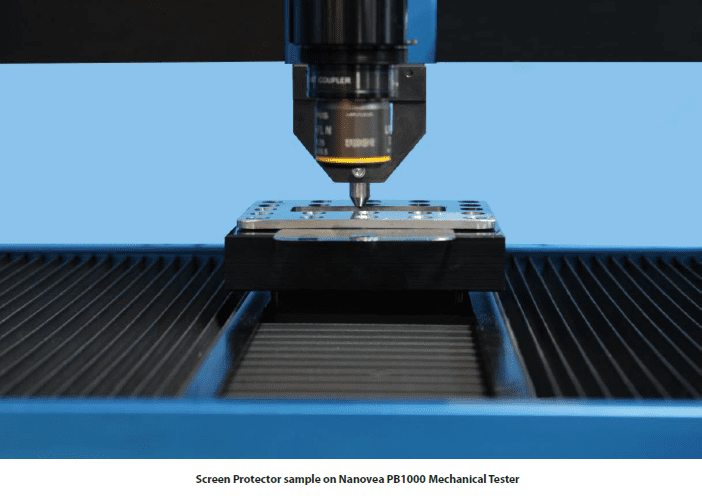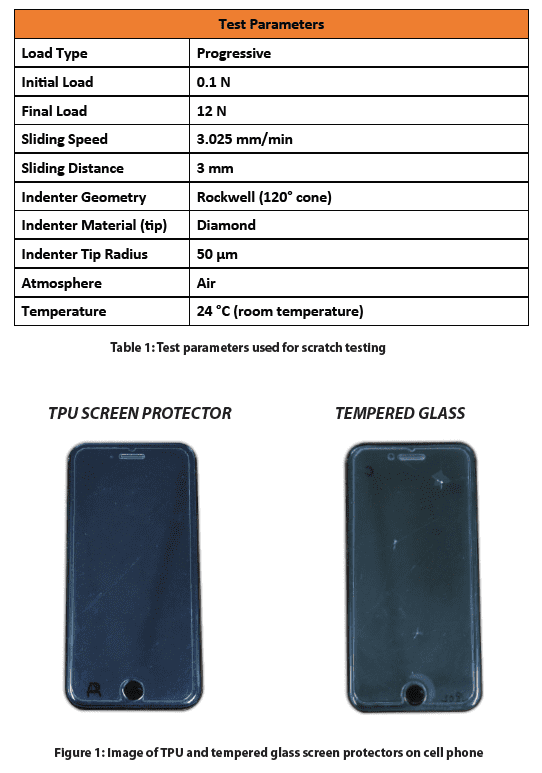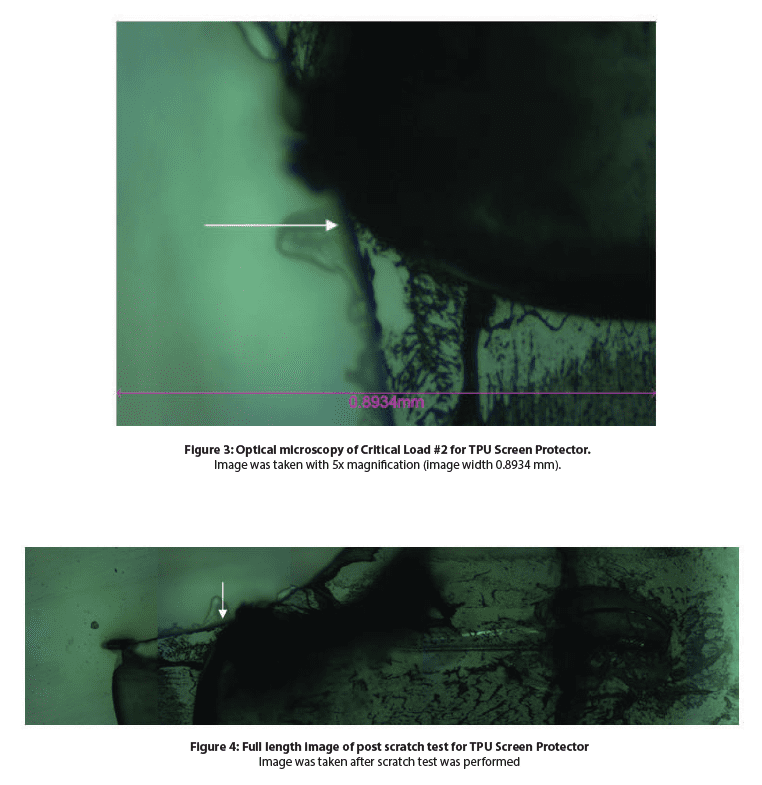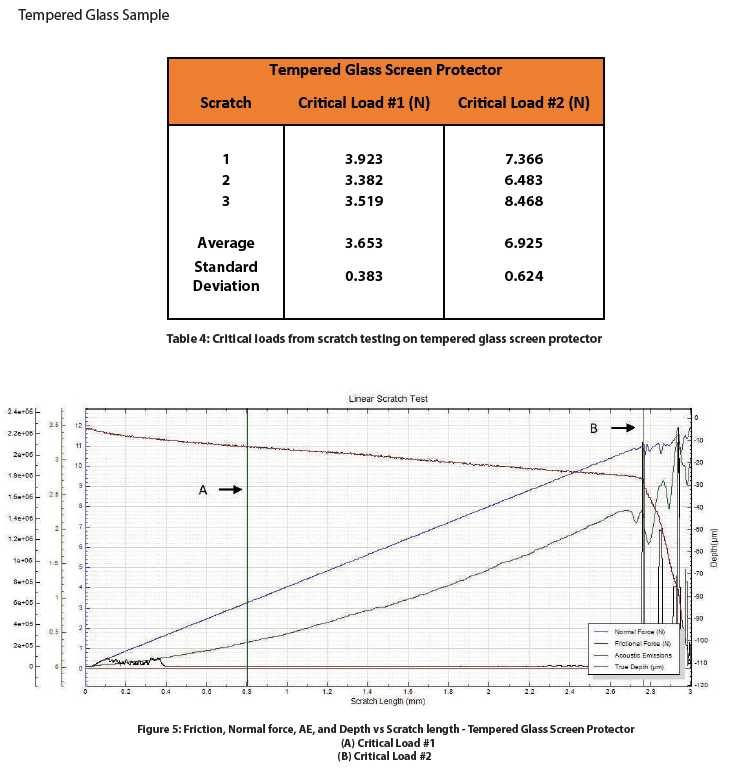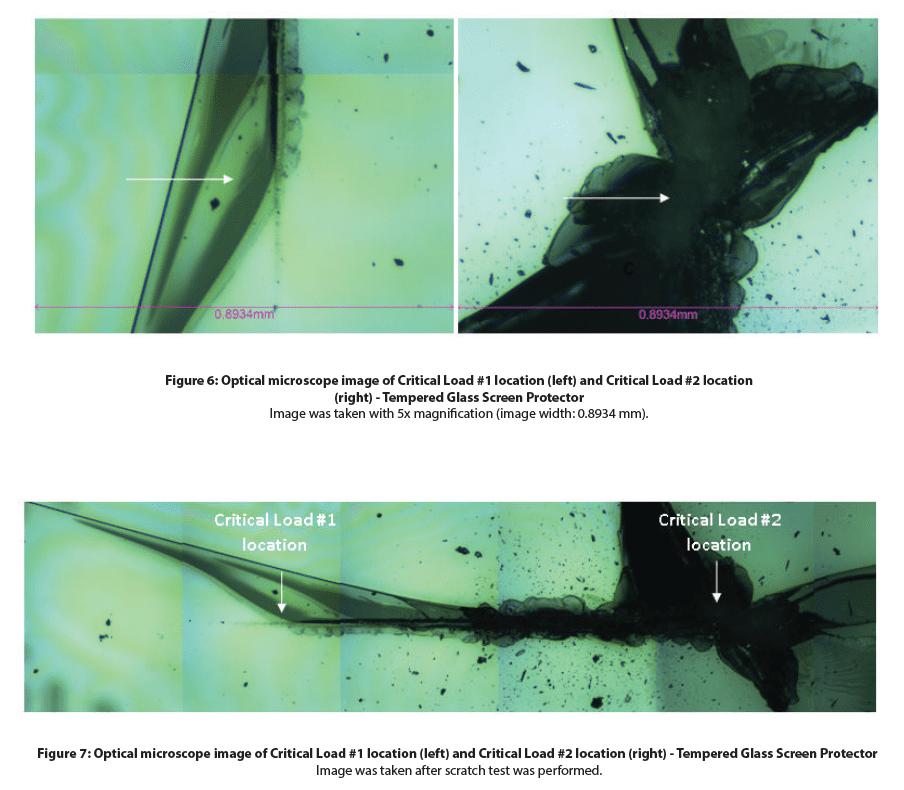
Scratch Resistance of Cellphone Screen Protectors
Importance of Testing Screen Protectors
Although phone screens are designed to resist shattering and scratching, they are still susceptible to damage. Daily phone usage causes them to wear and tear, e.g. accumulate scratches and cracks. Since repairing these screens can be expensive, screen protectors are an affordable damage prevention item commonly purchased and used to increase a screen’s durability.
Using the Nanovea PB1000 Mechanical Tester’s Macro Module in conjunction with the acoustic emissions (AE) sensor, we can clearly identify critical loads at which screen protectors show failure due to scratch1 testing to create a comparative study between two types of screen protectors.
Two common types of screen protector materials are TPU (thermoplastic polyurethane) and tempered glass. Of the two, tempered glass is considered the best as it provides better impact and scratch protection. However, it is also the most expensive. TPU screen protectors on the other hand, are less expensive and a popular choice for consumers who prefer plastic screen protectors. Since screen protectors are designed to absorb scratches and impacts and are usually made of materials with brittle properties, controlled scratch testing paired with in-situ AE detection is an optimal test setup for determining the loads at which cohesive failures (e.g. cracking, chipping and fracture) and/or adhesive failures (e.g. delamination and spallation) occur.
Measurement Objective
In this study, three scratch tests were performed on two different commercial screen protectors using Nanovea’s PB1000 Mechanical Tester’s Macro Module. By using an acoustic emissions sensor and optical microscope, the critical loads at which each screen protector showed failure(s) were identified.
Test Procedure and Procedures
The Nanovea PB1000 Mechanical Tester was used to test two screen protectors applied onto a phone screen and clamped down to a friction sensor table. The test parameters for all scratches are tabulated in Table 1 below.
Results and Discussion
Because the screen protectors were made of a different material, they each exhibited varying types of failures. Only one critical failure was observed for the TPU screen protector whereas the tempered glass screen protector exhibited two. The results for each sample are shown in Table 2 below. Critical load #1 is defined as the load at which the screen protectors started to show signs of cohesive failure under the microscope. Critical load #2 is defined by the first peak change seen in the acoustic emissions graph data.
For the TPU screen protector, Critical load #2 correlates to the location along with the scratch where the protector began to visibly peel off the phone screen. A scratch appeared on the surface of the phone screen once Critical load #2 was surpassed for the remainder of the scratch tests. For the Tempered Glass screen protector, Critical load #1 correlates to the location where radial fractures began to appear. Critical load #2 happens towards the end of the scratch at higher loads. The acoustic emission is a larger magnitude than the TPU screen protector, however, no damage was done to the phone screen. In both cases, Critical load #2 corresponded to a large change in depth, indicating the indenter had pierced through the screen protector.
Conclusion
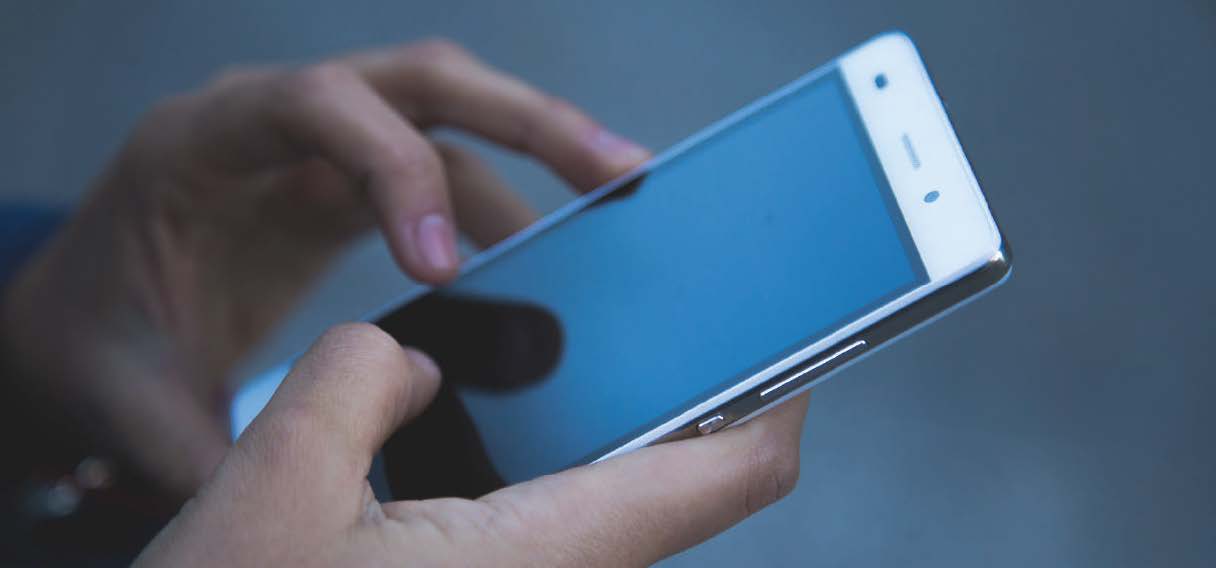
In this study we showcase the Nanovea PB1000 Mechanical Tester’s ability to perform controlled and repeat-able scratch tests and simultaneously use acoustic emission detection to accurately identify the loads at which adhesive and cohesive failure occur in screen protectors made of TPU and tempered glass. The experimental data presented in this document supports the initial assumption that Tempered Glass performs the best for scratch prevention on phone screens.
The Nanovea Mechanical Tester offers accurate and repeatable indentation, scratch, and wear measurement capabilities using ISO and ASTM compliant Nano and Micro modules. The Mechanical Tester is a complete system, making it the ideal solution for determining the full range of mechanical properties of thin or thick, soft or hard coatings, films, and substrates.
NOW, LET'S TALK ABOUT YOUR APPLICATION
Categories
- Application Notes
- Block on Ring Tribology
- Corrosion Tribology
- Friction Testing | Coefficient of Friction
- High Temperature Mechanical Testing
- High Temperature Tribology
- Humidity and Gases Tribology
- Humidity Mechanical Testing
- Indentation | Creep and Relaxation
- Indentation | Fracture Toughness
- Indentation | Hardness and Elastic
- Indentation | Loss and Storage
- Indentation | Stress vs Strain
- Indentation | Yield Strength and Fatigue
- Laboratory Testing
- Linear Tribology
- Liquid Mechanical Testing
- Liquid Tribology
- Low Temperature Tribology
- Mechanical Testing
- Press Release
- Profilometry | Flatness and Warpage
- Profilometry | Geometry and Shape
- Profilometry | Roughness and Finish
- Profilometry | Step Height and Thickness
- Profilometry | Texture and Grain
- Profilometry | Volume and Area
- Profilometry Testing
- Ring on Ring Tribology
- Rotational Tribology
- Scratch Testing | Adhesive Failure
- Scratch Testing | Cohesive Failure
- Scratch Testing | Multi-Pass Wear
- Scratch Testing | Scratch Hardness
- Scratch Testing Tribology
- Tradeshow
- Tribology Testing
- Uncategorized
Archives
- September 2023
- August 2023
- June 2023
- May 2023
- July 2022
- May 2022
- April 2022
- January 2022
- December 2021
- November 2021
- October 2021
- September 2021
- August 2021
- July 2021
- June 2021
- May 2021
- March 2021
- February 2021
- December 2020
- November 2020
- October 2020
- September 2020
- July 2020
- May 2020
- April 2020
- March 2020
- February 2020
- January 2020
- November 2019
- October 2019
- September 2019
- August 2019
- July 2019
- June 2019
- May 2019
- April 2019
- March 2019
- January 2019
- December 2018
- November 2018
- October 2018
- September 2018
- July 2018
- June 2018
- May 2018
- April 2018
- March 2018
- February 2018
- November 2017
- October 2017
- September 2017
- August 2017
- June 2017
- May 2017
- April 2017
- March 2017
- February 2017
- January 2017
- November 2016
- October 2016
- August 2016
- July 2016
- June 2016
- May 2016
- April 2016
- March 2016
- February 2016
- January 2016
- December 2015
- November 2015
- October 2015
- September 2015
- August 2015
- July 2015
- June 2015
- May 2015
- April 2015
- March 2015
- February 2015
- January 2015
- November 2014
- October 2014
- September 2014
- August 2014
- July 2014
- June 2014
- May 2014
- April 2014
- March 2014
- February 2014
- January 2014
- December 2013
- November 2013
- October 2013
- September 2013
- August 2013
- July 2013
- June 2013
- May 2013
- April 2013
- March 2013
- February 2013
- January 2013
- December 2012
- November 2012
- October 2012
- September 2012
- August 2012
- July 2012
- June 2012
- May 2012
- April 2012
- March 2012
- February 2012
- January 2012
- December 2011
- November 2011
- October 2011
- September 2011
- August 2011
- July 2011
- June 2011
- May 2011
- November 2010
- January 2010
- April 2009
- March 2009
- January 2009
- December 2008
- October 2008
- August 2007
- July 2006
- March 2006
- January 2005
- April 2004


